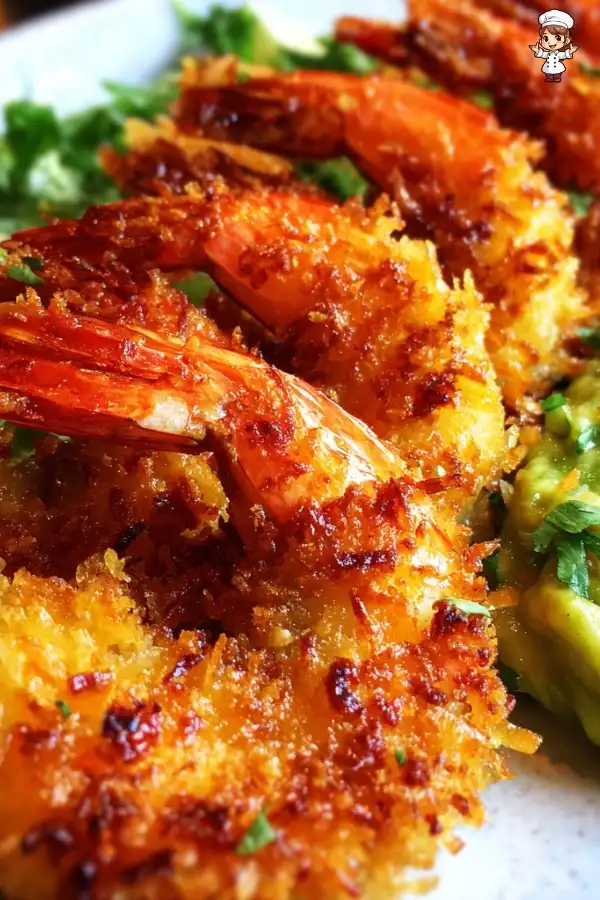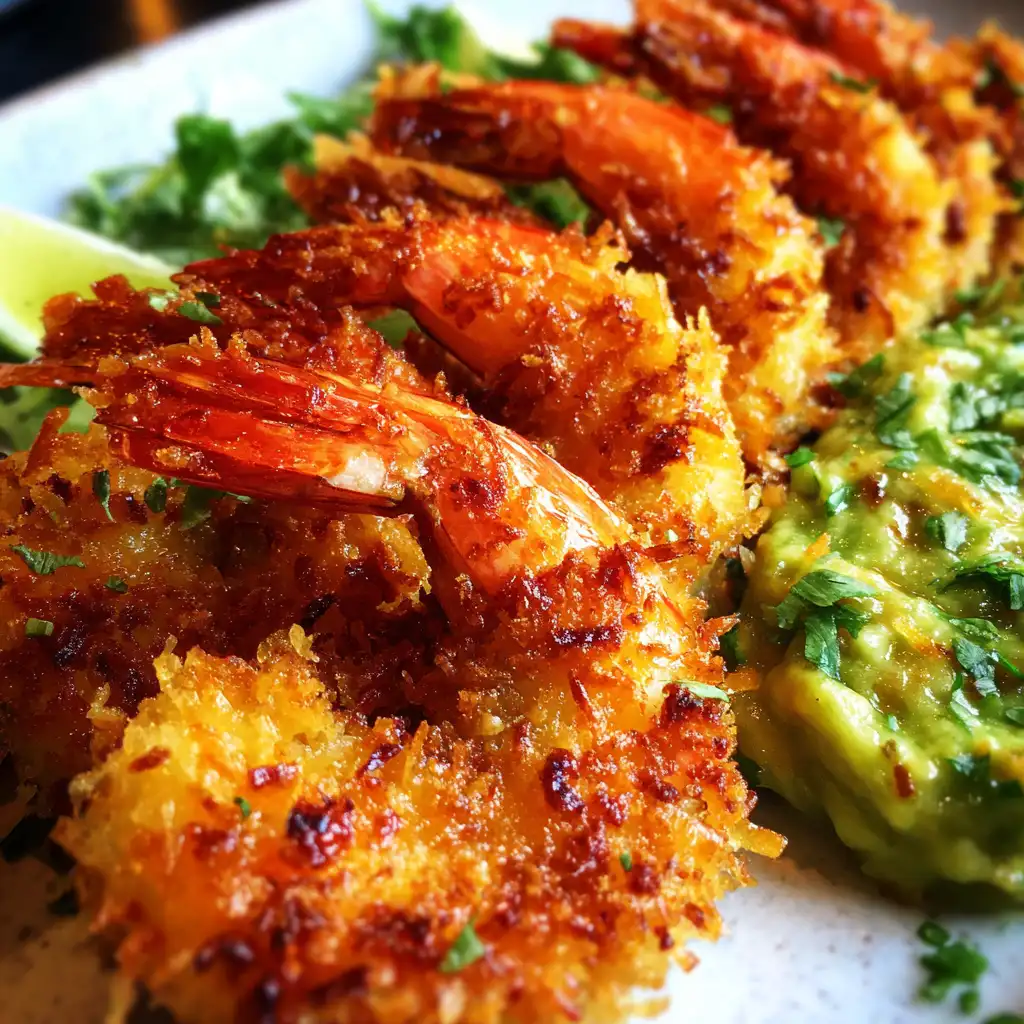Are you ready to embark on a culinary adventure? Baked Thai Coconut Shrimp with Lemongrass Guacamole is a dish that brings the vibrant flavors of Thailand right to your kitchen. This delightful recipe combines crispy coconut shrimp with a creamy, zesty guacamole, creating a perfect balance of textures and tastes. Whether you’re hosting a dinner party or simply treating yourself, this dish is sure to impress.
What Makes Baked Thai Coconut Shrimp with Lemongrass Guacamole Unique?
What sets Baked Thai Coconut Shrimp with Lemongrass Guacamole apart from other shrimp dishes? First, the shrimp are coated in a crunchy mixture of shredded coconut and panko breadcrumbs, giving them a delightful crunch. The addition of Thai red curry paste adds a subtle heat and depth of flavor that elevates the dish.
Next, the lemongrass guacamole is a refreshing twist on traditional guacamole. The fresh lemongrass adds a citrusy aroma that complements the rich avocado perfectly. This unique combination not only enhances the flavor but also provides a tropical flair that transports you to a sunny beach with every bite.
Moreover, this dish is baked instead of fried, making it a healthier option without sacrificing taste. The baking process allows the shrimp to cook evenly while retaining their juiciness. Plus, it’s easy to prepare, making it a great choice for both novice and experienced cooks alike.
In summary, Baked Thai Coconut Shrimp with Lemongrass Guacamole is not just a meal; it’s an experience. With its unique flavors and textures, this dish is bound to become a favorite in your household. So, let’s dive into the ingredients and preparation to bring this tropical delight to your table!
Ingredients for Baked Thai Coconut Shrimp with Lemongrass Guacamole
Essential Ingredients for the Shrimp
To create the perfect Baked Thai Coconut Shrimp, you need a few essential ingredients. Each one plays a vital role in delivering that delightful flavor and texture. Here’s what you’ll need:
- Large shrimp: 1 lb, peeled and deveined. Fresh shrimp is best, but frozen shrimp can work too if thawed properly.
- Shredded coconut: 1 cup, choose between sweetened or unsweetened based on your taste preference. Sweetened coconut adds a hint of sweetness, while unsweetened offers a more traditional flavor.
- Panko breadcrumbs: 1 cup. These Japanese-style breadcrumbs provide an extra crunch that makes the shrimp irresistible.
- Thai red curry paste: 2 tablespoons. This ingredient adds a unique flavor and a touch of heat to the shrimp.
- Eggs: 2 large. They act as a binding agent, helping the coconut and breadcrumbs stick to the shrimp.
- Salt: 1/2 teaspoon. A little salt enhances all the flavors in the dish.
Key Ingredients for the Lemongrass Guacamole
The lemongrass guacamole is what truly sets this dish apart. It’s fresh, zesty, and complements the shrimp beautifully. Here’s what you’ll need for this vibrant guacamole:
- Avocado: 2 ripe avocados. They should be soft to the touch for the best flavor and creaminess.
- Fresh lemongrass: 1 stalk, finely minced. This adds a refreshing citrusy flavor that brightens the guacamole.
- Lime juice: 2 tablespoons, freshly squeezed. Lime juice not only adds tanginess but also helps prevent the avocado from browning.
- Fresh cilantro: 1/4 cup, chopped. This herb adds a burst of freshness and a hint of earthiness.
- Salt: to taste. Adjust according to your preference for seasoning.
With these ingredients, you’re well on your way to creating a delicious dish that’s sure to impress. Now, let’s move on to the preparation steps to bring this delightful recipe to life!
Preparation of Baked Thai Coconut Shrimp with Lemongrass Guacamole

Step-by-Step Instructions for Baked Thai Coconut Shrimp
Step 1: Preparing the Shrimp
First, let’s get the shrimp ready. Start by rinsing the large shrimp under cold water. This helps remove any residual salt or ice if they are frozen. After rinsing, pat them dry with paper towels. This step is crucial because it helps the coating stick better. Next, in a medium bowl, mix the Thai red curry paste with the eggs. Whisk them together until they are well combined. This mixture will give the shrimp a flavorful base.
Step 2: Coating the Shrimp
Now, it’s time to coat the shrimp! Set up your coating station with three bowls. In the first bowl, you have the egg and curry mixture. In the second bowl, place the shredded coconut, and in the third bowl, add the panko breadcrumbs. Take each shrimp and dip it into the egg mixture first. Make sure to let any excess egg drip off. Then, roll the shrimp in the shredded coconut, pressing gently to ensure it sticks. Finally, coat the shrimp in the panko breadcrumbs for that extra crunch. Place each coated shrimp on the prepared baking sheet in a single layer. This ensures they cook evenly.
Step 3: Baking the Shrimp
With all the shrimp coated, it’s time to bake! Slide the baking sheet into your preheated oven at 400°F (200°C). Bake the shrimp for about 15-20 minutes. Keep an eye on them! You want them to turn golden brown and be firm to the touch. The internal temperature should reach 120°F (49°C) for perfectly cooked shrimp. Once done, remove them from the oven and let them cool slightly while you prepare the guacamole.
Step-by-Step Instructions for Lemongrass Guacamole
Step 1: Preparing the Ingredients
While the shrimp are baking, let’s whip up that delicious lemongrass guacamole! Start by gathering your ingredients. You’ll need ripe avocados, fresh lemongrass, lime juice, cilantro, and salt. Cut the avocados in half and remove the pits. Scoop the flesh into a mixing bowl. Make sure the avocados are ripe for the best flavor and creaminess. Next, finely mince the lemongrass stalk. This will add a refreshing zing to your guacamole.
Step 2: Mixing the Guacamole
Now, it’s time to mix everything together! Using a fork, mash the avocados until they reach your desired level of smoothness. Some people like it chunky, while others prefer it creamy. Once mashed, stir in the minced lemongrass, freshly squeezed lime juice, and chopped cilantro. Add salt to taste, adjusting it based on your preference. Give it a good mix until everything is well combined. Your guacamole should be vibrant and full of flavor!
Tips for Perfecting Baked Thai Coconut Shrimp with Lemongrass Guacamole
Cooking Tips for the Shrimp
To ensure your Baked Thai Coconut Shrimp turns out perfectly, here are some helpful cooking tips. First, always use fresh shrimp if possible. Fresh shrimp has a better texture and flavor compared to frozen. If you must use frozen shrimp, make sure to thaw them completely and pat them dry before coating.
Next, consider marinating the shrimp in lime juice and a pinch of salt for 15-30 minutes before coating. This step enhances the shrimp’s flavor and adds a nice tang. Additionally, when coating the shrimp, make sure to press the coconut and breadcrumbs firmly onto the shrimp. This helps them stick better during baking, resulting in a crunchier texture.
Lastly, keep an eye on the baking time. Ovens can vary, so check the shrimp a few minutes before the suggested time. You want them golden brown and firm to the touch. Overcooking can lead to rubbery shrimp, so be cautious!
Enhancing the Flavor of Lemongrass Guacamole
To take your lemongrass guacamole to the next level, consider these flavor-enhancing tips. First, use ripe avocados for the best creaminess. If your avocados are not ripe enough, they won’t mash well, and the guacamole will lack that smooth texture.
For an extra kick, add a pinch of chili flakes or diced jalapeños to the guacamole. This will give it a spicy twist that pairs beautifully with the coconut shrimp. You can also experiment with adding diced tomatoes or red onion for added texture and flavor.
Lastly, don’t forget to taste and adjust the seasoning! A little extra lime juice or salt can make a big difference. The balance of flavors is key, so make sure it’s just right before serving. With these tips, your lemongrass guacamole will be a hit!
Variation of Baked Thai Coconut Shrimp with Lemongrass Guacamole
Alternative Ingredients for the Shrimp
If you want to switch things up a bit, there are several alternative ingredients you can use for the shrimp. For instance, you can try using different types of seafood. Scallops or fish fillets can be great substitutes. They will absorb the flavors of the Thai red curry paste beautifully.
Another option is to use a gluten-free breadcrumb alternative. There are many brands that offer gluten-free panko breadcrumbs, which will still give you that satisfying crunch. If you’re looking for a lower-carb option, consider using crushed nuts like almonds or macadamia nuts instead of breadcrumbs. This will add a unique flavor and texture to your dish.
For those who prefer a milder taste, you can reduce the amount of Thai red curry paste or even use a different seasoning blend. A simple mix of garlic powder, paprika, and a hint of cayenne can provide a delicious flavor without the heat. Feel free to experiment with these alternatives to find the perfect combination that suits your taste!
Creative Twists on Lemongrass Guacamole
When it comes to guacamole, the possibilities are endless! To give your lemongrass guacamole a creative twist, consider adding different ingredients. For example, diced mango or pineapple can add a sweet and tropical flavor that pairs wonderfully with the shrimp.
Another fun idea is to incorporate roasted garlic. Simply roast a few cloves of garlic until they are soft and caramelized, then mash them into the guacamole. This will add a rich, savory depth to the dish.
If you enjoy a bit of heat, try adding finely chopped jalapeños or a splash of hot sauce. This will give your guacamole a spicy kick that complements the coconut shrimp perfectly. You can also mix in some diced red onion or bell peppers for added crunch and color.
Lastly, consider garnishing your guacamole with toasted sesame seeds or crushed peanuts. This will not only enhance the flavor but also add a delightful crunch. With these creative twists, your lemongrass guacamole will be a standout side dish!
FAQs
Can I use frozen shrimp for Baked Thai Coconut Shrimp with Lemongrass Guacamole?
Yes, you can use frozen shrimp for this recipe! Just make sure to thaw them completely before cooking. To thaw, place the shrimp in the refrigerator overnight or run them under cold water for a quick thaw. After thawing, pat them dry with paper towels to ensure the coating sticks well. Using frozen shrimp can be a convenient option, and they will still taste delicious in your baked Thai coconut shrimp!
What can I serve with Baked Thai Coconut Shrimp with Lemongrass Guacamole?
Baked Thai Coconut Shrimp with Lemongrass Guacamole is versatile and pairs well with various sides. You can serve it with a fresh salad, such as a cucumber or mango salad, to add a refreshing crunch. Additionally, jasmine rice or coconut rice complements the dish beautifully, soaking up the flavors. For a fun twist, consider serving it with tortilla chips for dipping into the guacamole. This dish is perfect for sharing, so feel free to get creative with your sides!
How do I store leftovers of Baked Thai Coconut Shrimp with Lemongrass Guacamole?
If you have leftovers, store them in separate airtight containers. The shrimp can be kept in the refrigerator for up to 2 days. To reheat, place them in the oven at 350°F (175°C) for about 10 minutes until warmed through. The guacamole should also be stored in the fridge, but it’s best enjoyed fresh. If you notice browning, a splash of lime juice can help keep it vibrant. Consume the guacamole within 1-2 days for the best taste!
Is Baked Thai Coconut Shrimp with Lemongrass Guacamole suitable for meal prep?
Absolutely! Baked Thai Coconut Shrimp with Lemongrass Guacamole is a great option for meal prep. You can prepare the shrimp and guacamole ahead of time and store them in separate containers. This makes it easy to grab a quick meal during the week. Just remember to reheat the shrimp before serving, and enjoy the fresh guacamole cold. It’s a delicious and healthy meal that you can look forward to throughout the week!
Print
Baked Thai Coconut Shrimp with Lemongrass Guacamole
- Total Time: 40 minutes
- Yield: 4 servings
- Diet: Gluten Free
Description
Baked Thai Coconut Shrimp with Lemongrass Guacamole is a dish that combines crispy coconut shrimp with a creamy, zesty guacamole, creating a perfect balance of textures and tastes.
Ingredients
- Large shrimp: 1 lb, peeled and deveined
- Shredded coconut: 1 cup
- Panko breadcrumbs: 1 cup
- Thai red curry paste: 2 tablespoons
- Eggs: 2 large
- Salt: 1/2 teaspoon
- Avocado: 2 ripe avocados
- Fresh lemongrass: 1 stalk, finely minced
- Lime juice: 2 tablespoons, freshly squeezed
- Fresh cilantro: 1/4 cup, chopped
- Salt: to taste
Instructions
- Rinse the shrimp under cold water and pat dry with paper towels.
- In a medium bowl, mix the Thai red curry paste with the eggs and whisk until combined.
- Set up a coating station with three bowls: egg mixture, shredded coconut, and panko breadcrumbs.
- Dip each shrimp into the egg mixture, then roll in shredded coconut, and finally coat with panko breadcrumbs.
- Place the coated shrimp on a prepared baking sheet in a single layer.
- Bake in a preheated oven at 400°F (200°C) for 15-20 minutes until golden brown and firm to the touch.
- While the shrimp are baking, prepare the guacamole by mashing the avocados in a bowl.
- Stir in minced lemongrass, lime juice, chopped cilantro, and salt to taste until well combined.
Latest Amazon Finds
Notes
- Use fresh shrimp for the best flavor and texture.
- Consider marinating the shrimp in lime juice and salt for added flavor.
- Press the coconut and breadcrumbs firmly onto the shrimp for better adherence.
- Check the shrimp a few minutes before the suggested baking time to avoid overcooking.
- Prep Time: 20 minutes
- Cook Time: 20 minutes
- Category: Appetizer
- Method: Baking
- Cuisine: Thai
Nutrition
- Serving Size: 1 serving
- Calories: 350
- Sugar: 2g
- Sodium: 400mg
- Fat: 20g
- Saturated Fat: 8g
- Unsaturated Fat: 10g
- Trans Fat: 0g
- Carbohydrates: 30g
- Fiber: 5g
- Protein: 15g
- Cholesterol: 150mg
Keywords: Baked Thai Coconut Shrimp, Lemongrass Guacamole, Thai Cuisine, Seafood Recipe








